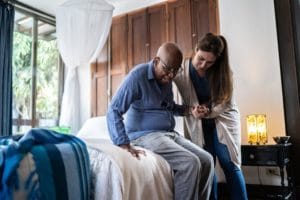
Florida is a super hot travel destination for seniors during the winter for many reasons, both for fun and health. So if you are considering becoming a snowbird, find out if Florida is a good choice for your winter stay. You can also discover how to handle your car insurance if you store your car for extended trips and other car scenarios for prospective snowbirds.
Is Florida the best fit for my winter escape?
There are many perks to vacationing in Florida for the winter. The Sunshine State can range from fun, exciting, social, and charming to calming, beautiful, relaxing, and serene.
It is frequently listed as a number one winter destination for the elderly population as compared to even other similar destinations. This is in part because seniors can readily find a blend between city and nature. There are also many activities that are exciting, healthy, or an ideal combo of both.
Staying active after retirement is very important. So, as a senior, you may want to know which of these activities is right for you. Fortunately, Florida is rich with activities that are beneficial to physical health, as well as activities that keep you more energetic and lively. The following list provides some great suggestions to get a feel for Florida.
11 Senior-Friendly Activities Found in Florida
#1 – Yoga
There are many studios for yoga found throughout the Sunshine State. And even more exciting is that it is highly popular for groups to get together on the beach to enjoy the sunset and ocean breeze. Yoga is known to help with age-related muscle issues and can also bring a sense of inner calm from meditation.
#2 – Aqua Zumba
If you are looking for a smart workout that blends yoga, stretching, and dancing, look into aqua Zumba. It is an aerobic workout, but because it is in the water, it is softer on the tendons and joints.
#3 – Dolphin cruises
There is an abundance of prime locations for sighting dolphins and other sea life. You can look into cruises that specialize in finding the best spots for frequent dolphin spotting and even grab dinner and go shelling on the same trip.
#4 – Dance classes
A great way for seniors to stay social and active is to sign up for dance classes. Florida has a large elderly community, and so it is easy to find a community of like-minded people looking for a fun opportunity to dance and keep engaged.
#5 – Massage
Along with yoga studios, there are many massage studios (or studios offering both) in Florida. Types of massage include reiki, deep tissue, chiropractors, and less intensive types. Find out what is right for you, as a massage might be the perfect thing for your health.
#6 – Hiking
For those looking to stay fitter and enjoy a more intensive activity that is still outdoorsy, scenic, and calming, Florida has great hiking trails. These trails can be hiked solo or in groups, making hiking available as a social activity as well as a meditative one.
#7 – Tennis
Another perk of Florida is that many communities will have their own outdoor tennis courts because the weather is so nice. So it is very easy to find local tennis courts, which is a great way to meet your winter neighbors and keep fit.
#8 – Snorkeling
The Florida Keys offer the best snorkeling if you wish to view vibrant, colorful tropical fish, conchs, urchins, sea turtles, coral reefs, and more. But you can even find sand dollars, crabs, and beautiful shells on more northern beaches in Florida.
#9 – Fishing
Fishing is a great way to get outdoors, enjoy the beautiful scenery, and relax in a less strenuous outdoor activity. Florida has both freshwater and saltwater fishing, a variety of places you choose from, including piers, boats, and chartering, and many species of fish.
#10 – Golf
Golf courses are a very popular amenity in many retirement communities throughout Florida. Some of the biggest golf courses are located in Florida, such as the courses in The Villages retirement community, just north of Orlando. This community boasts 50 golf courses and almost 700 holes.
#11 – Shopping
After long days in the sun, sometimes retreating to a cool, indoor mall is just the thing you need. You’ll find plenty of name brands to choose from, including high-end retailers such as Neiman Marcus, Louis Vuitton, and Burberry. And of course, charming local boutiques abound.
In fact, these activities can help combat the growing issue of loneliness among seniors. So allowing yourself to indulge in these types of things can truly help your sense of well-being and enrich your quality of life.
If you find Florida to look highly appealing for your winter stay, the next question is how to take care of seemingly complicated car and travel logistics to make your dream a reality.
Ways Snowbirds Can Store, Ship, and Insure Cars for Florida
There are multiple routes you can take when it comes to making arrangements for your car. It is much more effective and safe to have at least one car with you during your winter stay. Uber and Lyft can get you around on a vacation, but it is not a feasible long-term solution. They are often too expensive and less flexible in where they can take you.
So you’ll want to have your vehicle in Florida.
Some snowbirds have been known to drive themselves on a long, cross-country road trip. However, this may not be the easiest route, as it can cause a lot of wear and tear to do annually. And it is definitely not the safest route either. Furthermore, overnight stays can get expensive on the road trip, so this is not the most cost-effective option.
Another option is to ship your car through a car shipping service. With these services, your car is attached to a trailer, and then someone drives the trailer south to Florida. Then you can fly by plane for a much quicker, safer, and cost-effective trip. And there are thousands of routes between U.S. cities in the North and Florida.
If you’re on the East Coast, a second way to ship your car is by train, such as Amtrak. This requires driving part of the way to the station in Norton, Virginia. Then you can board the train for the rest of the journey, in addition to shipping your car on the train as well. This option reduces the length of the trip by about a day and reduces any wear and tear on your car.
Whether you choose to ship or drive your car, Florida requires anyone with a car to register it if they have been there for more than 90 days. And according to Florida law, any vehicle with a current Florida registration must have a minimum of $10,000 in personal injury protection (PIP) as well as a minimum of $10,000 in property damage liability (PDL).
Also, snowbirds will often have multiple vehicles. If you have multiple vehicles, naturally you’ll want to find a way to save on insurance if you store one at your northern home. A great option is to look into parked auto insurance, which is a pause on your regular insurance.
Parked auto insurance is cheaper and covers a variety of scenarios that can occur with a car in storage. These scenarios include a limb falling on your vehicle while parked, vandalism, natural disaster, and more. They do often require that you own a second vehicle; additionally, the stored car cannot be driven for the duration of time it is in storage.
Travel can be both exhilarating and a little daunting. But the more familiar you are with the logistics you need to take care of to have a smooth trip, the more fun it is.
Dorothea Hudson writes and researches for the auto insurance comparison site, BuyAutoInsurance.com. She has extensive travel experience and lives in Florida.









